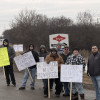Members participate in Labor 2006 to get out the vote and the message
WITH DOZENS OF governor, Senate, House, and state legislative positions in play, 2006 presented a real opportunity for working families to take back control from the anti-worker majority that held power. And that is just what workers did, tipping the scales back in favor of the Democratic Party.
All across the country, Boilermakers participated in Labor 2006 — an AFL-CIO program designed to get-out-the-vote and educate workers about political candidates. Ready to restore a much-needed balance to Capitol Hill, Boilermakers worked hard to get their fellow workers and families engaged in political action.
They not only “walked the walk,” performing door-to-door canvassing, but they “talked the talk,” too, educating their families and co-workers on where candidates stood on working people’s issues — health care, jobs, pensions, and workers’ freedom to form unions.
Labor 2006 focused on grass-roots mobilization to dramatically expand the reach of the member-to-member program to educate and activate more union members to vote. It also linked politics and organizing by asking all endorsed candidates to provide support for organizing and contract negotiations.
The Boilermakers’ government affairs department concentrated its energy in Ohio, Pennsylvania, and Virginia, where strong labor candidates were opposing incumbents who have stood against Boilermaker issues.
“The three Senate races the Boilermakers focused on were Brown (OH), Casey (PA), and Webb (VA). In all of these races Boilermaker locals were engaged in the AFL-CIO Labor 2006 program,” said Shannon Brett, assistant to the director of the government affairs department.
Boilermakers knocked on labor’s doors for both candidate persuasion and get-out-the-vote efforts. They also phoned members as part of their campaign strategy. In addition, locals were encouraged to send political flyers and a letter from their business manager or president to their membership.
“On top of the local mail that went out, the government affairs department also targeted drop-off voters in each of these states,” Brett continued. “Members who voted in the 2004 presidential election but not in the 2002 elections were sent a separate piece of mail, highlighting the issues and candidates in their states.”
And all of their efforts paid off in a big way, with Democrats regaining control of both houses of Congress.






